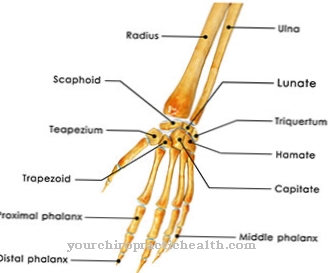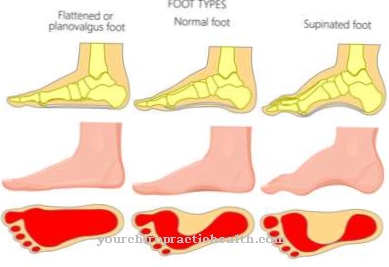rheumatism, Rheumatoid arthritis or chronic polyarthritis are terms for a rheumatic disease. Rheumatism can also be divided into inflammatory and degenerative rheumatic diseases.
What is rheumatism?

© curto - stock.adobe.com
rheumatism is the generic term for a variety of painful conditions of the musculoskeletal system. Not only the bones are always affected, but also the connective tissue on and in the joints. Rheumatism, which takes place in the connective tissue, is counted as a collagenosis (connective tissue disease). Collagen is a protein-like component of connective tissue.
Collagen connective tissue is found in the skin, bones, tendons, cartilage, muscles, and blood vessels. Collagen gives strength and support to other structures in the body. Degenerative joint diseases such as osteoarthritis is a rheumatic disease. Thanks to modern medical diagnostics, it is now possible to better diagnose the approx. 200 different rheumatic diseases, even if not completely cured.
causes
For the disease rheumatism there are a variety of causes. First and foremost is a malfunctioning immune system (autoimmune disease). The immune system recognizes some of the body's own structures as foreign bodies and tries to fight them, which results in inflammatory reactions. Today the autoantibodies can be differentiated very well in the laboratory, so that early detection is possible.
The autoimmune disease rheumatism has a familial component, i. rheumatic diseases occur more frequently in some families. Infections with streptococci, borrelia, chlamydia or the effects of moisture, cold or toxins can trigger rheumatism. Psoriasis can also affect the joints and / or the spine. The occurrence of rheumatism is linked to certain processes in the blood. It is believed that a particular form of allergy is present. This causes a sensitization of the joint surfaces.
The human immune system can then recognize these as foreign tissue and react. Translated rheumatism means "to flow, flow, tear". And that's exactly how those affected describe the pain associated with rheumatism.
Symptoms, ailments & signs
The first sign of rheumatism is morning stiffness, which can be associated with mild pain. After a few minutes of movement, the affected joints become more flexible again. It can be one or more fingers. The ankles can also be affected. As the disease progresses, the duration of morning stiffness increases significantly. The painful joint complaints can also occur when the patient is resting.
Swelling forms in the affected joint areas. The restrictions on movement increase. In addition to functional complaints, changes in shape can occur. The pain that occurs can appear as pulling, tearing or flowing. In addition to the joints, inflammatory rheumatoid disease (arthritis) can also affect bones, muscles and ligaments. The number of affected parts of the body increases.
The left and right halves of the body are affected. The symptoms can also occur in larger joints such as the shoulder joint or knee joint. Bony deformities can form over a long period of time due to rheumatism. With rheumatic disease in the form of arthritis, the inflammatory processes also affect the organs and nervous system.
General feelings of illness such as night sweats, exhaustion and excessive tiredness as well as weight loss may develop. Rheumatic symptoms can appear intermittently. In the case of a rheumatic disease in the form of gout, severe pain suddenly occurs in a certain joint (gout attack). Signs of soft tissue rheumatism are pain in muscles, tendons, cartilage and fat tissue.
Course of disease

rheumatism as a disease has many faces over time. It can be acute, intermittent or chronic. Rheumatism manifests itself through tenderness, pain and stiffness of the muscles and joints. In the early stages, many sufferers complain of tiredness and morning stiffness of the entire musculoskeletal system. At this stage only slight changes in the blood count can be seen.
If some joints are swollen, inflamed and very painful in the acute phase, deformations (visible changes) remain. Some collagenosis rheumatic diseases have symptoms of fatigue, fever, loss of appetite and weight loss as their symptoms. However, rheumatism can also take place for several years without any signs of illness and thus without impairing everyday life.
Complications
Rheumatism or rheumatoid arthritis can cause various complications. This danger arises especially if there is no suitable treatment. The most common sequelae of rheumatic diseases include swelling in the metacarpophalangeal and medial joints. The change in the joints is gradual and can take up to ten years.
While some joints hyperextend, others become flexed incorrectly. It is not uncommon for so-called rheumatic nodules to form on the extensor side of the joint. In the adjacent area, the affected people often suffer from bone loss (osteoporosis), whereby the bone loses its strength. In addition, bone defects develop in the edge area of the joints, which medicine calls erosions. Even with the help of medical therapy, the symptoms can often only be alleviated.
Another complication is the spread of the rheumatoid nodules into the intestines. The nodules are often painless, but in some cases they cause discomfort, which primarily affects heavily stressed body regions.
If the rheumatism continues, this has a negative effect on the gripping functions of the hands. This in turn can result in the need for care of those affected. Around ten percent of all rheumatism patients suffer from severe disabilities. In the worst case, the diseased joints will be destroyed.
Carpal tunnel syndrome is also one of the rheumatoid complications. The rheumatoid arthritis causes pressure damage to the nerves, which causes pain and paralysis of the hand muscles.
When should you go to the doctor?
The first sign of rheumatic disease is morning stiffness. The fingers, joints or feet can only be moved with difficulty or hardly at all. Full mobility is only achieved after several minutes. The affected areas often swell. In addition, there is a sensation of heat and discoloration of the skin. A doctor should be consulted at the first signs, since rheumatism is a chronic disease.
The sooner medical care begins, the better treatment options there are and the speed at which the disease progresses can be influenced. General restrictions on movement or mobility indicate impairment. Bad posture occurs and is a cause for concern. A doctor is required if the usual physical performance drops or if the pain persists.
It is not necessary to consult a doctor if the organism is overworked. In these cases, spontaneous healing occurs after a sufficient period of rest and a restful night's sleep. Research into the cause is indicated if the symptoms gradually increase, a feeling of illness occurs or the person concerned wakes up with night sweats. Fatigue or deformity of the skeletal system should be presented to a doctor. If joint pain occurs in a resting position, this is an alarm signal from the body that should be followed up.
Doctors & therapists in your area
Treatment & Therapy
The treatment options for rheumatism have become very diverse thanks to research and are better suited to individual rheumatic diseases. Despite everything, in acute cases, cortisone (cortisone) is the first drug. Cortisone allows the inflammation to subside. The chronic course of rheumatism also responds very well to cortisone. In the meantime there are new types of cortisone preparations that start working at night, so that the morning stiffness is less.
If cortisone does not bring the hoped-for relief, immunosuppressants are used. These are drugs that inhibit the body's natural defense reaction against its own tissues. The use of immunosuppressants can reduce the dose of cortisone. Every rheumatic sufferer should also adjust their diet to the disease. Since cortisone decalcifies the bones, a sufficient supply of calcium should not be missing. Ommega-3 fatty acids and vitamin E have a positive effect on rheumatism. Walks, swimming and physiotherapy relieve pain associated with rheumatism.
Aftercare
In order to relieve the symptoms of rheumatism, the sufferer must adjust their lifestyle accordingly. Diet plays an important role in this. Rheumatism research now knows that certain dietary patterns have a negative impact on the disease and can make symptoms worse. The patient should first aim for a normal body weight.
Rheumatic diseases require a predominantly plant-based diet, supplemented by low-fat dairy products and fish. Animal fats promote inflammation in the body and should therefore be avoided as far as possible. Omega-3 fatty acids, on the other hand, are said to have anti-inflammatory properties and should be supplied to the organism in sufficient quantities.
Rheumatics should therefore regularly incorporate high-fat sea fish such as herring, mackerel and salmon into their diet, about twice a week. Omega-3 fatty acids can also be found in vegetable oils, such as rapeseed, walnut or linseed oil, which are good for cooking and refining salads. To keep the body hydrated, water and unsweetened teas are ideal.
Alcohol consumption should be minimized. Regular exercise helps to maintain mobility and thus independence of the sick person. Moderate sports like swimming and cycling stabilize the general body feeling. Long walks are easy on the joints and also contribute to the patient's well-being. It helps many patients to exchange ideas with other affected persons in self-help groups and thereby alleviate psychological suffering.
You can do that yourself
The symptoms of rheumatism can be alleviated by the patient himself through lifestyle-dependent factors. Diet plays a very central role in this. Rheumatism researchers assume that certain nutritional patterns favor the development of symptoms or aggravate symptoms that have already occurred. It is worth striving for a normal body weight. When choosing food, food intolerances and possible concomitant diseases, such as cardiovascular diseases, should be taken into account.
For rheumatoid diseases, a mainly plant-based diet in combination with the consumption of low-fat dairy products and fish is recommended. Animal fats from eggs, meat, sausage products, liver or butter contain high amounts of arachidonic acid. This fatty acid promotes inflammation in the organism and should therefore be avoided as much as possible, especially in rheumatism.
Anti-inflammatory properties are mainly attributed to omega-3 fatty acids. These are mainly found in fatty sea fish such as herring, salmon and mackerel. People with rheumatism should therefore regularly incorporate fish into their diet, about twice a week. Other important suppliers of omega-3 fatty acids are vegetable oils from linseed, rapeseed and walnut oil. These are suitable for refining salads or for cooking. Rheumatism patients should ensure that they drink enough fluids in the form of water or unsweetened tea and at the same time keep their alcohol consumption as low as possible.
In order to maintain independence and mobility in everyday life, rheumatism patients should exercise regularly. Depending on the course of the disease and symptoms, joint-friendly sports such as cycling or swimming are recommended. Regular and long walks are suitable alternatives.
Furthermore, rheumatism patients can take part in self-help groups to exchange experiences with other sufferers. Regular visits to self-help groups help patients deal with everyday problems, give further individual tips and can significantly reduce psychological suffering.
Video: Proper nutrition for rheumatism



























